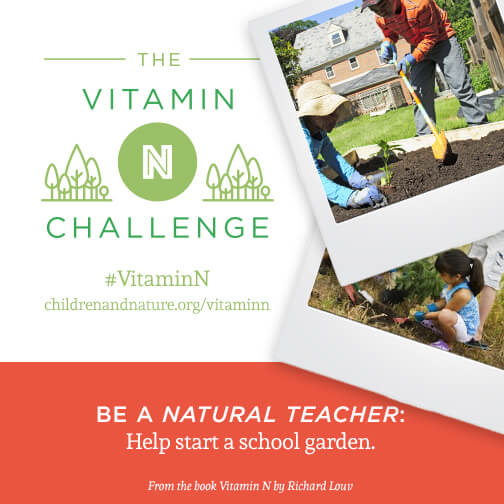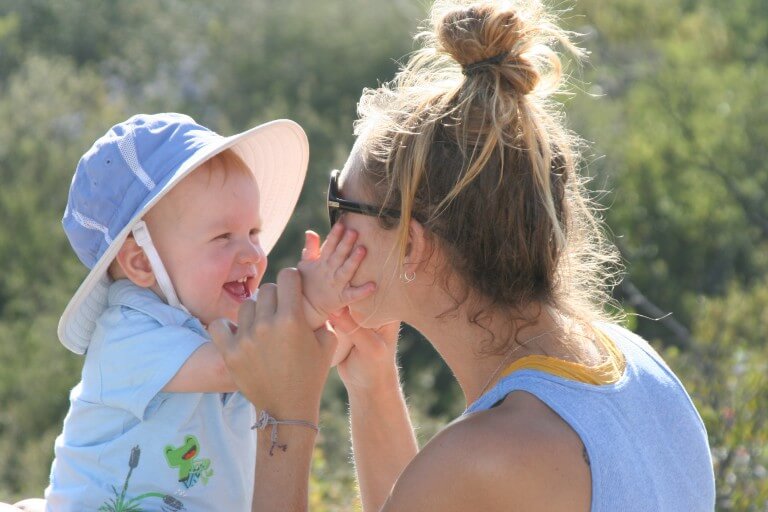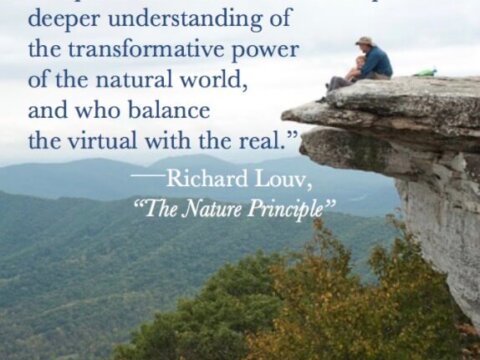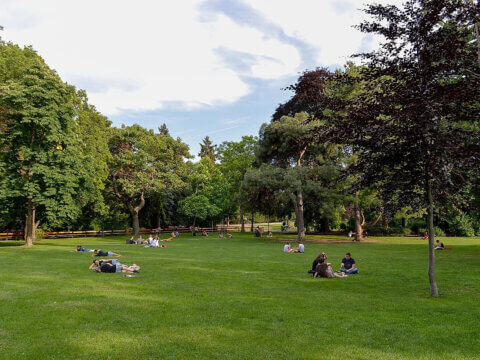Richard Louv
SCHOOL OF NATURE: 8 Ways to Jumpstart a Great School Year with a Dose of Vitamin N
A Natural Teacher is anyone who uses the power of nature as an environment for learning — not only about nature, but about any subject.
Professional educators, parents, grandparents, librarians, park rangers, the good folks who operate outdoor programs — can all be Natural Teachers. Here’s a sampling of ways to get going this year, excerpted from “Vitamin N: The Essential Guide to a Nature-Rich Life.”
- Give or assign books for nature inspiration. The books most likely to inspire children to head outdoors aren’t environmental sermons (plenty of time for those later), but about adventure and wonder. Such inspirational titles include Island of the Blue Dolphins, Julie of the Wolves, Tom Sawyer, The Jungle Book, and The Curious Garden. Read about nature together or encourage solo reading outdoors. Emphasize books specific to natural history — especially the natural history of your own backyard, city, and bioregion.
 Spend a half hour outdoors; write an instant nature essay. Parents, teachers and other adults can do this as well, but it can be especially effective with young people. A California high school biology teacher asked his students to spend a half hour outside — anywhere that they considered part of the natural world, whether it was an urban park, a yard, or a stream outside of town — and then write about their experiences. Recommended book: Keeping a Nature Journal by Clare Walker Leslie.
Spend a half hour outdoors; write an instant nature essay. Parents, teachers and other adults can do this as well, but it can be especially effective with young people. A California high school biology teacher asked his students to spend a half hour outside — anywhere that they considered part of the natural world, whether it was an urban park, a yard, or a stream outside of town — and then write about their experiences. Recommended book: Keeping a Nature Journal by Clare Walker Leslie.- Move the classroom outside. Learn how just about everything can be taught outside. Recommended book: Moving the Classroom Outdoors by Herb Broda. Create a sensory garden, using natural elements to stimulate the basic senses and other, lesser-known senses, including vestibular, proprioceptive, and kinesthetic senses. See the U.S. Fish and Wildlife Service’s Schoolyard Habitat Project Guide. Learn about school gardening projects at KidsGardening.org. Tap the knowledge of programs such as the Natural Learning Initiative. Check out the Green Schoolyards for Healthy Communities initiative, a C&NN partnership with the National League of Cities.
- Study bird behavior. Learn about bird language. Nature connection educator Jon Young’s book, What the Robin Knows: How Birds Reveal the Secrets of the Natural World, explores the ancient discipline of deep bird language, perfected by indigenous people around the world over, and science is finally catching up. Learn and practice bird calls. Recommended regional book series: The Backyard Birdsong Guide, by Donald Kroodsma.
- Hold a scavenger hunt. You don’t need Pokémon GO to know which way the wind blows. Scavenger hunts require no special materials – not even a smartphone. They’re fun and they can amplify concepts being taught in school. Ask kids to use their senses to find a soft object, something that makes a sound, something that smells good. Gather seeds, plant them later to see what grows. Look for a squirrel nest or insect home (but don’t disturb them). Find ten examples of weathering or camouflage. Scavenger Hunt Guru and the Nature Conservancy offer lists for urban nature hunts. Recommended: Leopold Exploration Cards from the Aldo Leopold Foundation.
 Create nature-based classrooms in the community beyond the school. Schools, families, businesses, parks, and outdoor organizations can work together to encourage parents to organize a family nature club or join an existing one, introduce students to nature centers and parks, and sponsor overnight trips. They can help develop safe, natural learning environments within walking distance of every school.
Create nature-based classrooms in the community beyond the school. Schools, families, businesses, parks, and outdoor organizations can work together to encourage parents to organize a family nature club or join an existing one, introduce students to nature centers and parks, and sponsor overnight trips. They can help develop safe, natural learning environments within walking distance of every school.- Get Every Kid in a Park. Every child deserves to experience wilderness or nearby urban nature. A White House initiative launched last year focuses on fourth graders, providing free admission for a whole year to all national parks and other federal lands and waters, including ones in highly urban areas. Children, their families, adult chaperones, and their schools are able to use the pass for multiple visits over the course of an entire year. Find out more here.
- Learn more about the benefits of nature-based education. In Finland, which is consistently near the top of the list in math and science testing (the United States is significantly lower on the list), students spend much of the day outdoors — no matter how cold the temperature. Recommended resources include C&NN’s special report on the benefits of natural learning environments, and Green Teacher magazine, available in English, Spanish, and French.
Comments
Additional Resources
- C&NN’s Research Library, including a report on research on nature and learning
- Project Learning Tree
- Project WILD
- The National Environmental Education and Training Foundation
- North American Association for Environmental Education
- The Center for Ecoliteracy
- Audubon Adventures
- National Wildlife Federation’s Eco-Schools USA
- Nature Explore
More reading and viewing:
In Case You Missed It
-
Network News
Earth Day: Young leaders advocate for change
-
Feature
Nature photographer Dudley Edmondson has a vision for the representation of Black and Brown faces in the outdoors
-
Richard Louv
EARTH MONTH: You're part of the New Nature Movement if....
-
Voices
Placemaking: How to build kinship and inclusive park spaces for children with disabilities
-
Network News
Children & Nature Network founders release report on global factors influencing the children and nature movement
Follow Us On







Commentaries on the C&NN website are offered to share diverse points-of-view from the global children and nature movement and to encourage new thinking and debate. The views and opinions expressed are those of the author(s) and do not necessarily reflect the position of C&NN. C&NN does not officially endorse every statement, report or product mentioned.